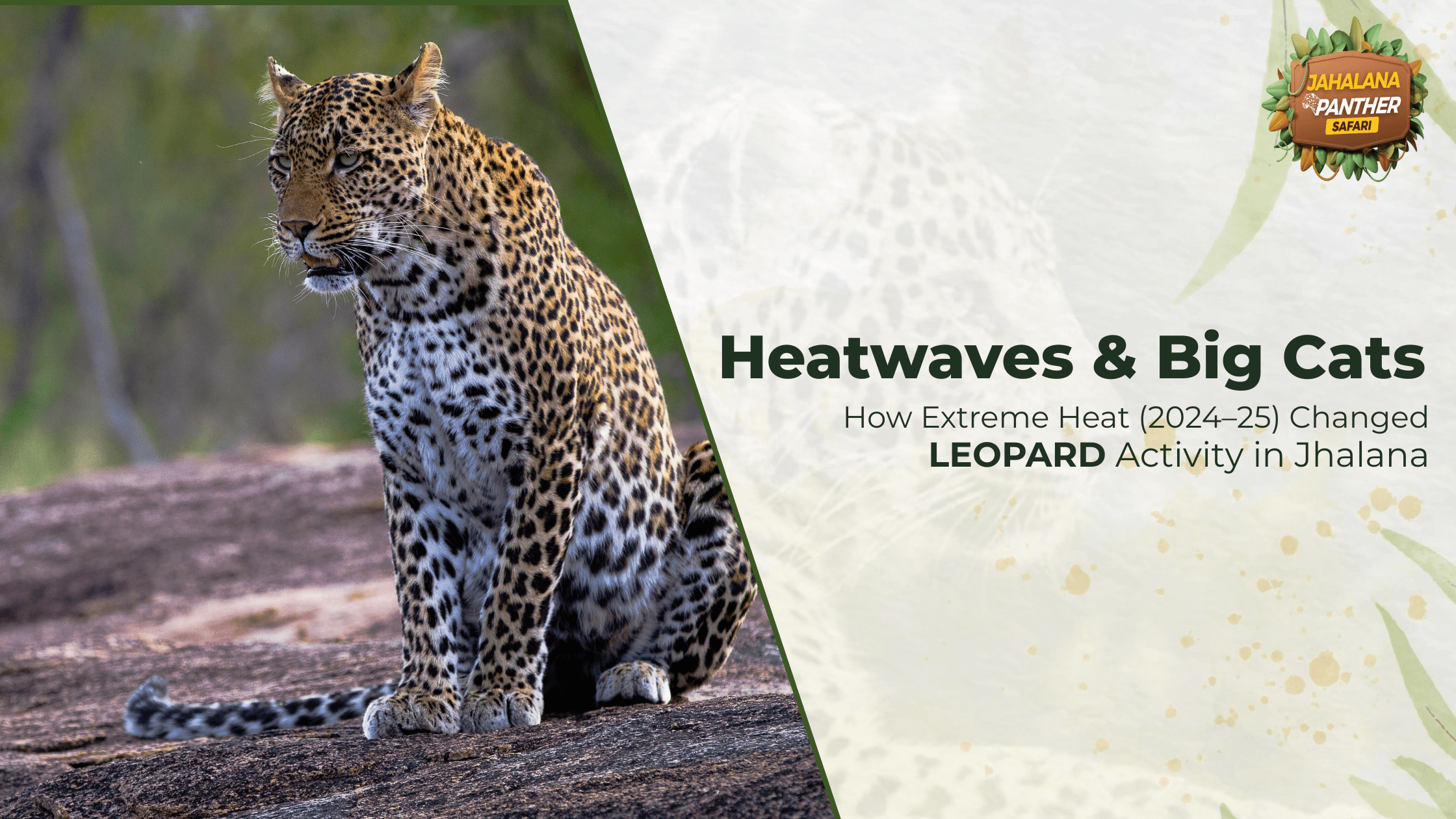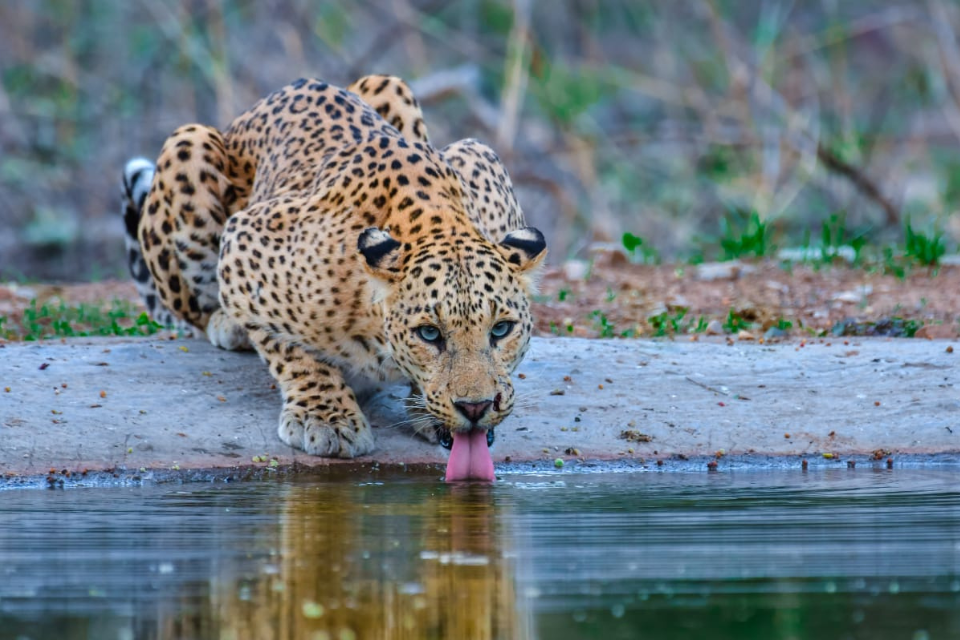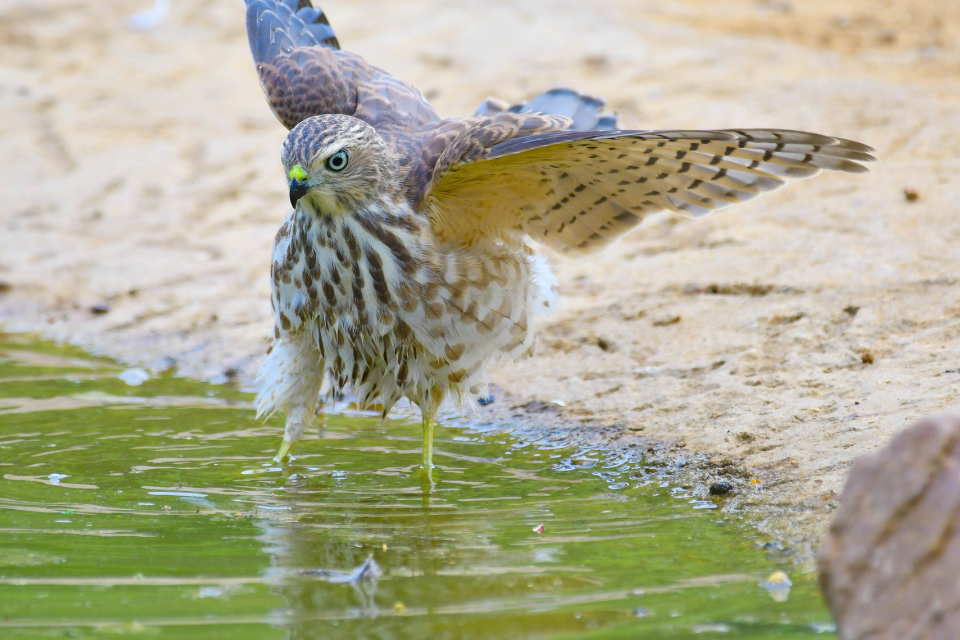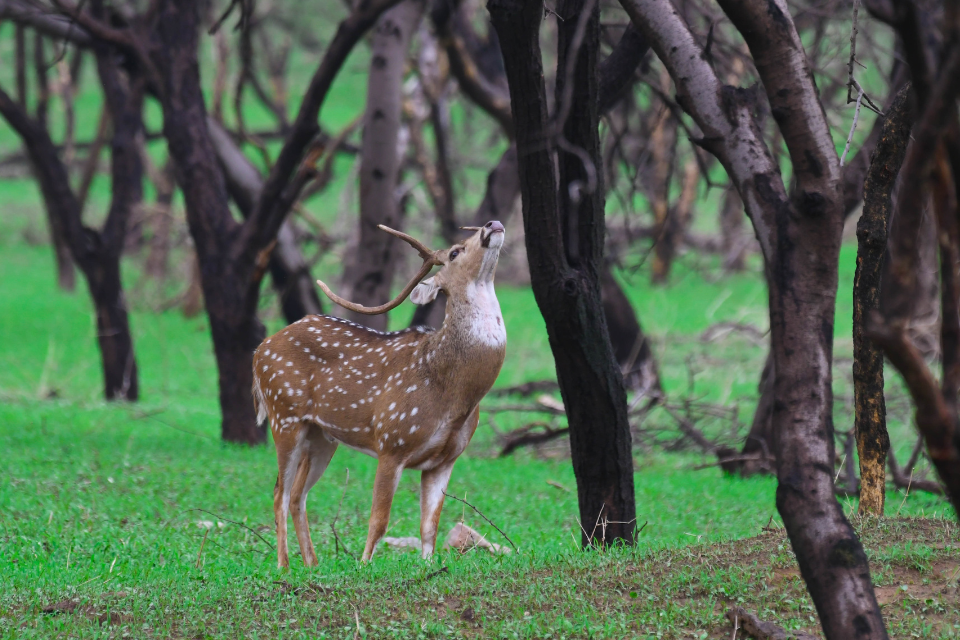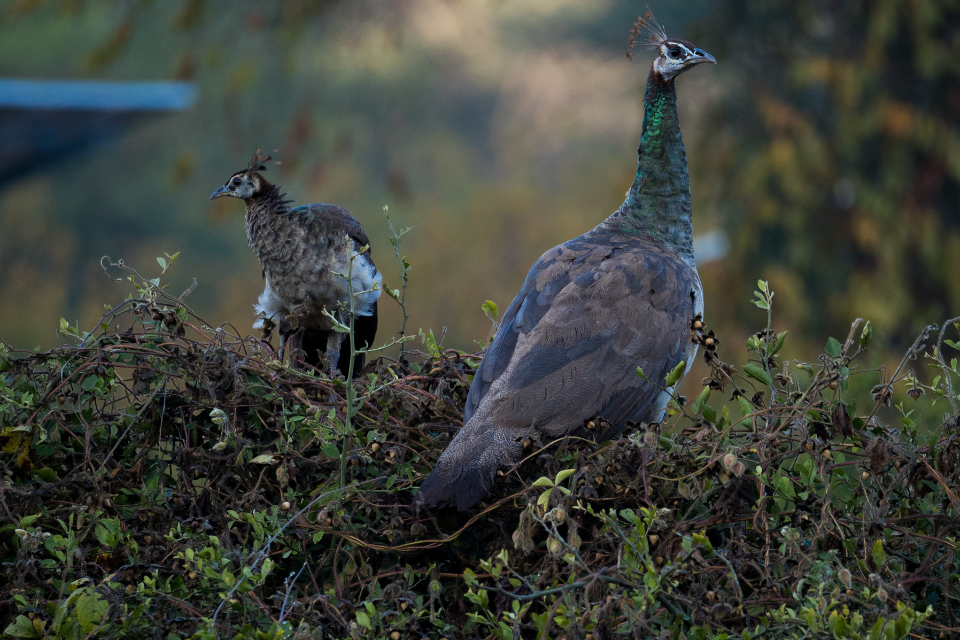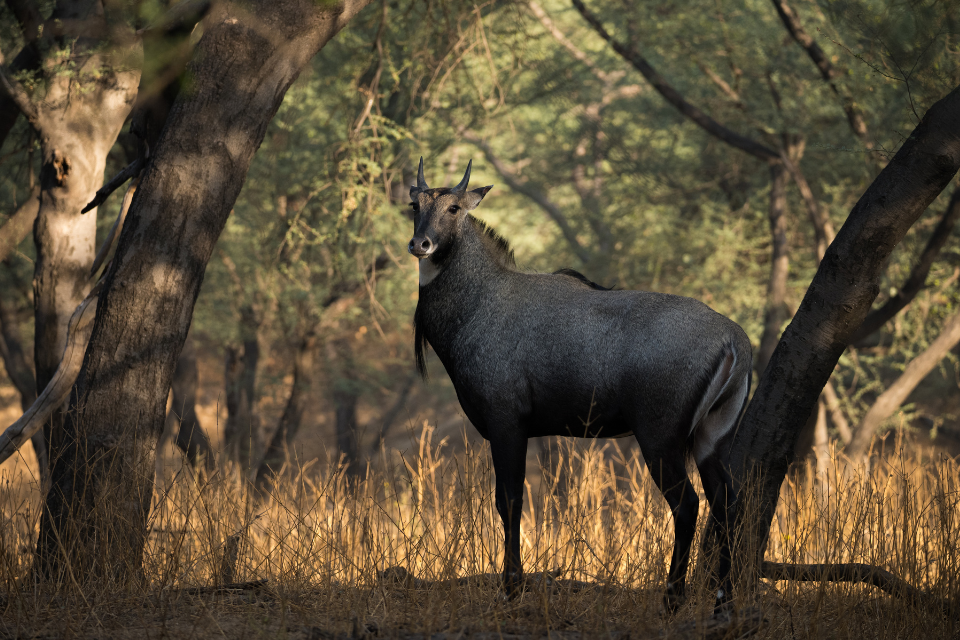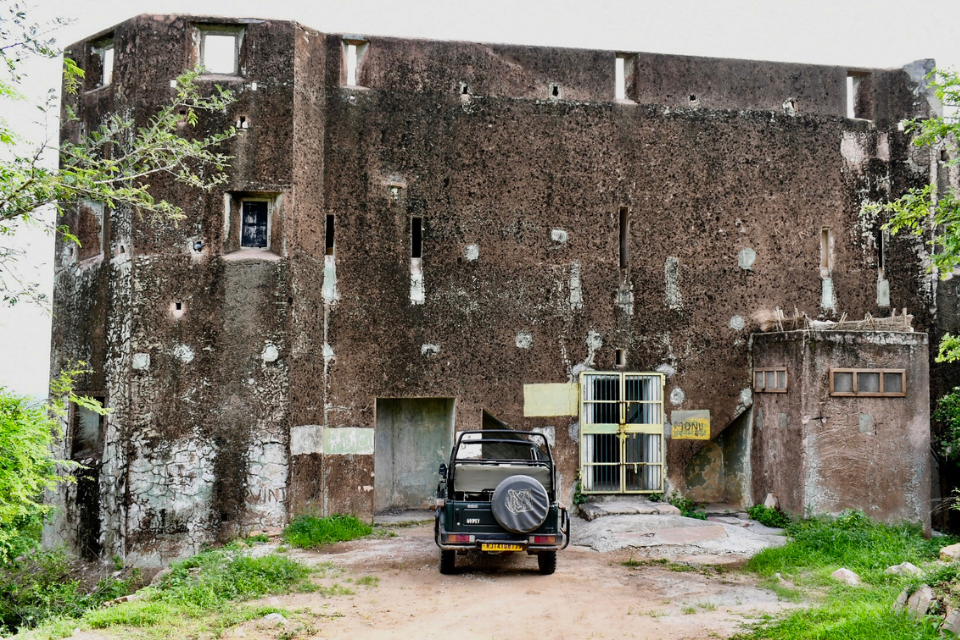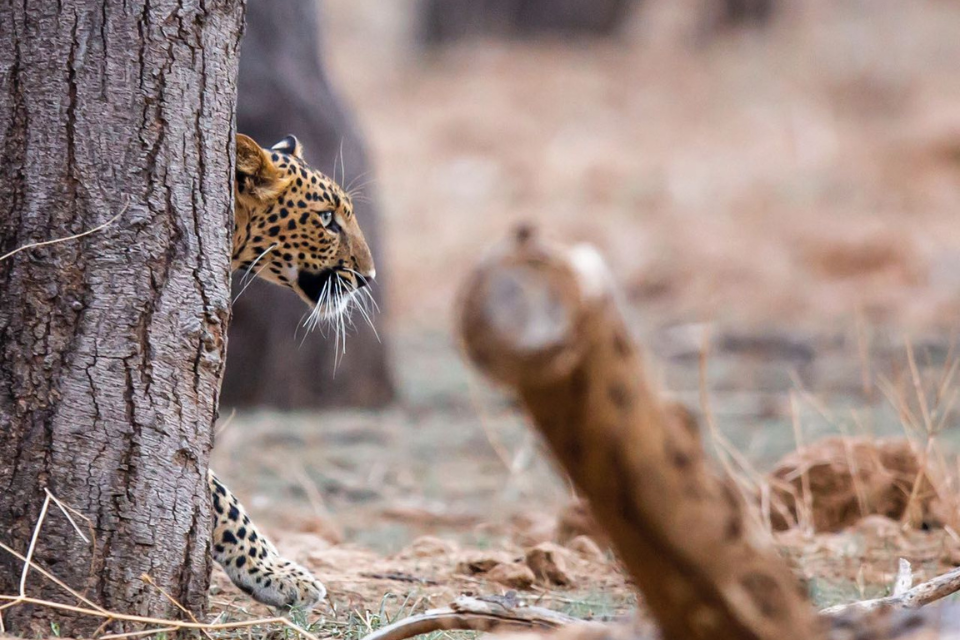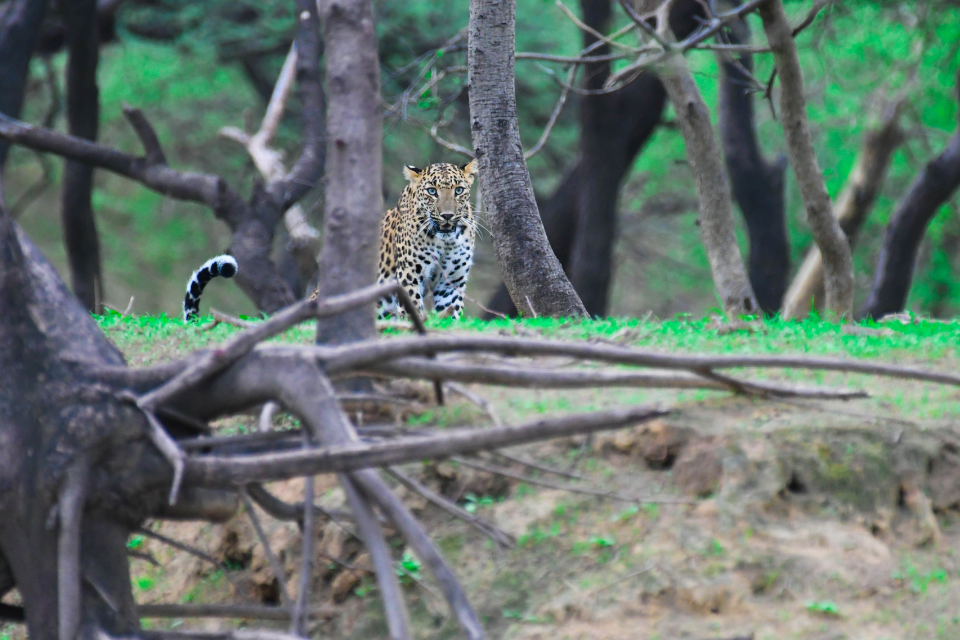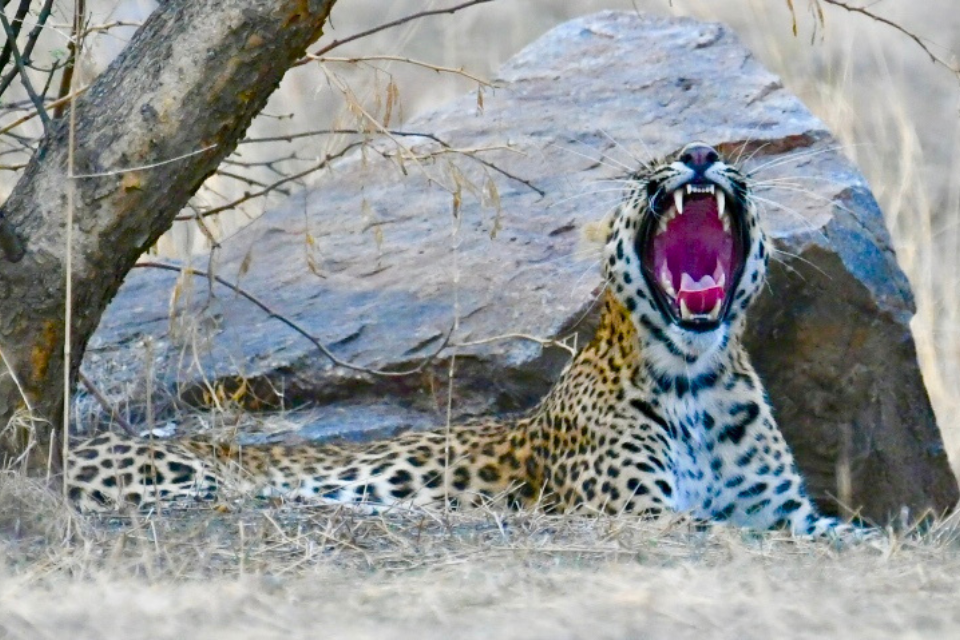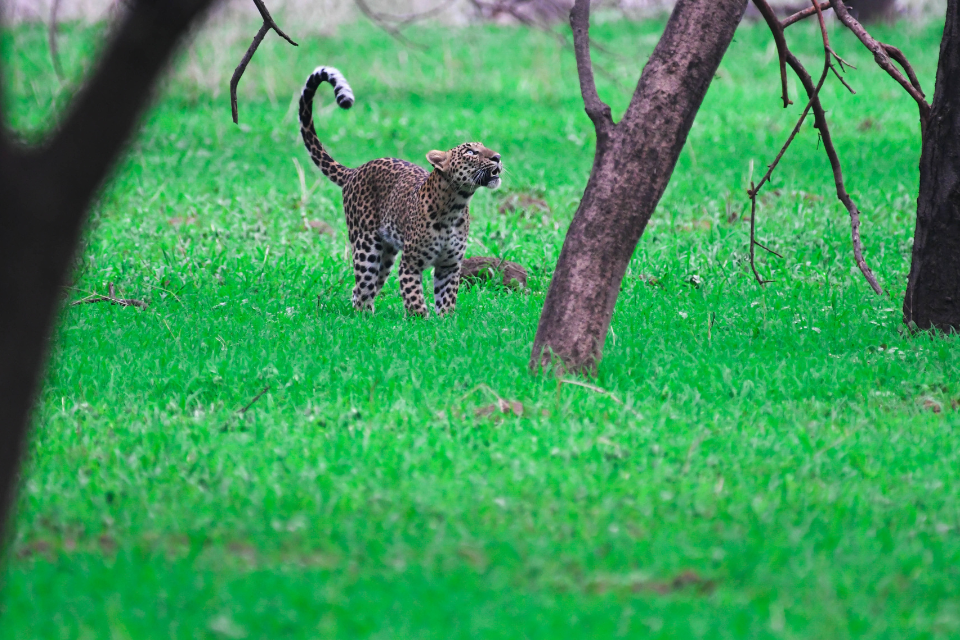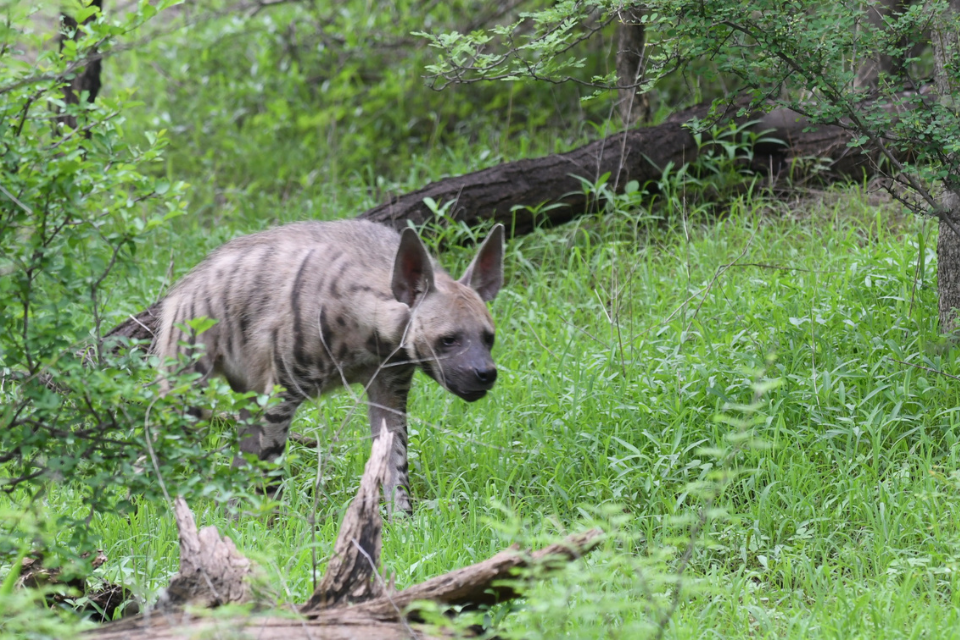- October 28, 2025
Heatwaves & Big Cats: How Extreme Heat (2024–25) Changed Leopard Activity in Jhalana
Overview
From April to June 2024, north and west India endured a punishing heatwave season, with the India Meteorological Department reporting multiple “severe heatwave” days and recorded highs like 50.5°C in Churu, Rajasthan. Jaipur itself flirted with the mid-40s multiple times and clocked 44.8°C on one of the season’s hottest days. 2025 brought an early spring escalation across Rajasthan, with Barmer capturing April heat records and dozens of stations crossing 43°C. These spikes weren’t one-off anomalies; they’re part of a trend of more frequent and longer heatwaves across South Asia.
Set against this backdrop is Jhalana–Amagarh, Jaipur’s celebrated urban leopard landscape, first notified as a leopard reserve in 2017, spanning roughly 20 km² in Jhalana and adjoining Amagarh forests. It is widely recognized for close-range leopard sightings and unusually high densities for an urban edge reserve.
This post unpacks how the 2024–25 heatwaves affected leopard behaviour in and around Jhalana, what guides and visitors actually observed or can expect, and how management is responding. We’ll combine site specifics with broader carnivore science to make sense of what changed—and why.
Heatwaves 2024–25: The Context that Shaped Behaviour
- 2024: A severe, prolonged heatwave spanned April–June. Rajasthan repeatedly featured among India’s hottest spots (e.g., 50.5°C in Churu). Delhi’s “record” 52.9°C reading was later attributed to a faulty sensor, but many north-Indian stations still exceeded 47–49°C; heatstroke cases exceeded 40,000 nationwide.
- Jaipur: The “Pink City” endured 44.8°C on one of its hottest 2025 pre-monsoon days, with IMD warning of persistent heat.
- Early 2025 signals: Rajasthan’s Barmer broke April records while ~30 stations crossed 43°C, underscoring a continuing pattern.
Why this matters for leopards: temperature directly influences activity timing in carnivores. Across guilds, rising heat pushes activity into cooler windows, alters prey movements, and can intensify night-time overlap between competitors. Multiple studies show temperature-driven shifts to later, darker hours; in cheetahs, extreme days increased nocturnality and overlap with other big cats. Similar dynamics have been documented across leopards and fellow carnivores in different ecosystems.
Jhalana’s Leopards: What’s Special About This Urban System?
- Location & size: Just minutes from Jaipur’s core, Jhalana is a compact ~20 km² reserve embedded in the Aravalli scrub-forest mosaic, now paired with Amagarh to form the Jhalana–Amagarh conservation landscape.
- Density & sightings: Jhalana is famed for frequent leopard sightings thanks to high leopard densities and short viewing distances—often 10–20 feet along tracks. A new 6 km safari route is being added from the old mine (Khan) to Neem Gatta to spread pressure and optimize sightings.
- Urban interface: The reserve’s edges abut neighbourhoods and landmarks; dispersing sub-adult males occasionally spill into city spaces, necessitating monitoring and safe capture protocols.
Takeaway: Jhalana’s combination of compact habitat, high leopard density, and urban edge effects makes thermal stress management—and visitor timing—especially consequential.
What Changed in 2024–25? A Field-Informed Synthesis
While every individual cat differs, guides and camera-trap timelines across hot months indicate several consistent shifts that align with broader carnivore research:
1) Activity shifted deeper into the night and bookended the day
- Later starts & earlier stops: On hotter days, leopards delayed diurnal movement and compressed crepuscular windows; peak activity clustered around pre-sunrise and post-sunset, with a more pronounced night-time bias during severe heat spells. This mirrors broader findings that ambient temperature reshapes carnivore temporal partitioning—pushing hunting and travel into cooler, darker hours.
- Comparative evidence: Cheetahs in extreme heat became more nocturnal; snow leopards show seasonal nocturnal peaks with sunrise/sunset spurts in warmer months—patterns consistent with thermoregulatory optimization.
2) Micro-habitat use intensified
- Shade & airflow: Leopards favoured north-facing slopes, ravines, rocky overhangs, and dense Prosopis/Acacia thickets that retain shade and cooler ground temperatures during mid-day.
- Water adjacency: On scorchers, cats were more frequently logged near artificial waterholes and vegetated drainages, not necessarily to drink more often but to capitalize on cooler microclimates and the presence of thermally stressed prey.
In semi-arid systems, activity often tracks prey behaviour rather than absolute temperature alone; but temperature shapes both predator and prey schedules, tightening nocturnal overlap.
3) Route learning and risk-aware movement
- In an urban edge reserve, human disturbance (pedestrians, vehicles) also nudges leopards toward the night. A 2025 multi-site analysis found timing of leopard activity strongly shifted away from periods of pedestrian movement, reinforcing the night bias in busier interfaces.
4) Diet & hunting windows re-weighted toward cooler hours
- Increased heat suppresses diurnal foraging by several prey species; crepuscular/nocturnal windows become more critical for stalks. When nights remain hot but breezier, leopards may gain scent and sound advantages over heat-dulled prey in scrubby terrain.
5) Edge spillovers: suburban forays during night heat
- With city edges often retaining tree cover, boundary walls, water storage, and peri-urban prey (dogs, pigs, nilgai corridors), a few individuals probed farther along safe corridors on hot nights—occasionally triggering urban alerts like the Moti Doongri incident.
Why Heat Forces These Shifts (The Science, Briefly)
- Thermoregulation: Leopards dissipate heat primarily via panting and behavioural adjustments (shade, water proximity, inactivity). Day-long exposure at 44–48°C raises metabolic stress and dehydration risk.
- Energetics: Hunting in hot, still air is costly. Waiting for cooler, windier nights reduces exertion and can conceal scent trails.
Guild dynamics: Studies show temperature alters carnivore overlaps, pushing many species into nocturnality, increasing encounters/competition after dark. That shift, seen in leopards and cheetahs elsewhere, scales to Jhalana’s compact matrix.
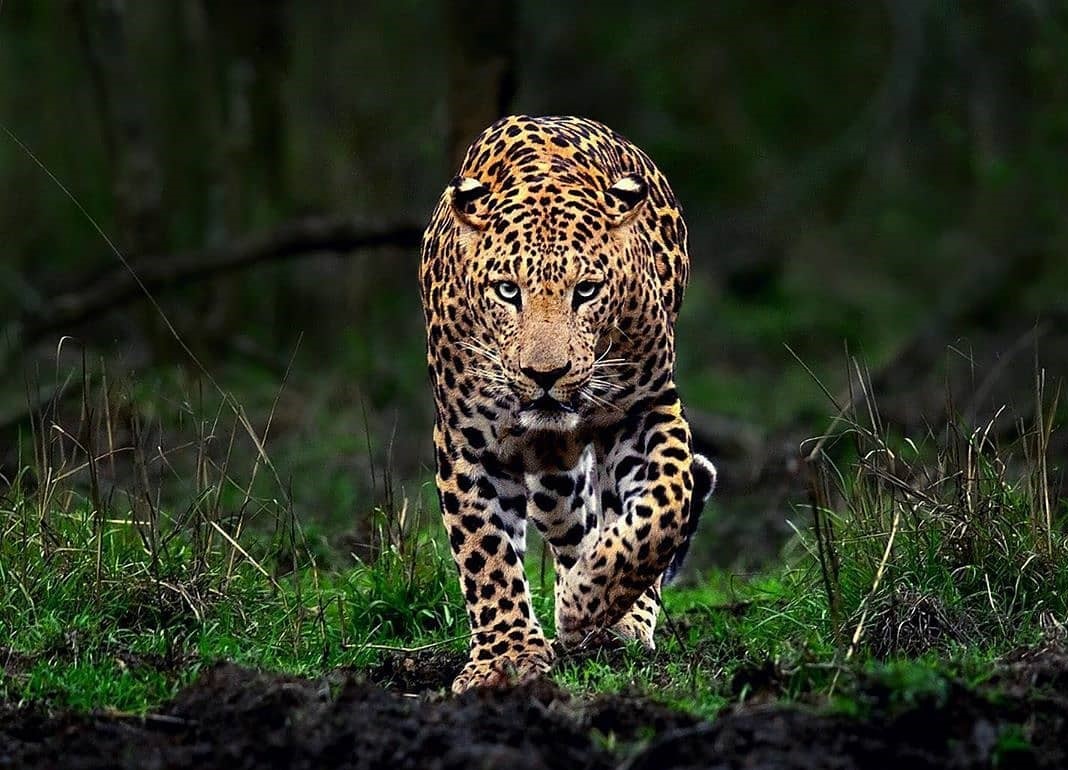
Implications for Visitors, Guides & Managers
For visitors (planning 2025–26 safaris)
- Choose slots smartly: In peak heat periods, book pre-sunrise or last-light drives; expect more nocturnal or crepuscular sightings relative to cool seasons. (Check permissible safari timings before planning.)
- Heat etiquette: Dress light, carry water, avoid loud talk near shade patches and ravines where cats rest.
- Monsoon crossover: Vegetation thickens post-rains; sightings can be closer but more fleeting—listen to your guide regarding angles and safe positioning.
For guides
- Shade-first tracking: Prioritize north-aspect gullies, rocky ledges, old mine collars (Khan area), Neem Gatta drainage on scorching days—places that hold shade and channel breeze. The new 6-km route will help distribute pressure and improve access to high-activity pockets.
- Sound discipline: Hot, still afternoons carry voices; coach guests on whispers at potential day beds.
- Thermal windows: When nights stay hot, push harder on pre-dawn; when an evening breeze kicks in, extend patient scanning into dusk.
For managers
- Water & vegetation strategy: Maintain staggered water points to prevent crowding, and patchy shade restoration (native trees, thorn scrub) along movement corridors.
- Visitor pressure spreading: Utilize the additional route to dilute traffic at core hotspots, especially in heatwaves when cats compress to fewer cool refugia.
- Edge monitoring & outreach: Proactive camera-trapping and neighbourhood advisories reduce conflict during night-time urban forays by dispersing sub-adults.
Field Notes: Timing by Season (Rule-of-Thumb)
- Peak heat (Apr–Jun):
- Highest leopard probability: Pre-sunrise (last hour of darkness) & post-sunset (first 60–90 minutes), with occasional late-night road crossings.
- Lower probability: Harsh mid-day (expect bedded cats in deep shade).
- Early monsoon (Jun–Jul):
- Activity: Brief spikes around rain-cooled breaks; cats use greened gullies; visuals may be close but momentary.
- Post-monsoon/winter (Oct–Feb):
- Activity broadens into daylight; more relaxed sightings and longer visuals on ledges—popular season for first-timers. (Many tour advisories list Oct–Mar as the most comfortable months.)
Conservation Crossroads: Urban Leopards in a Hotter Jaipur
Heatwaves amplify pressures in an already tight urban reserve: compressed shade refuges, busier night overlaps, and greater temptations along city edges (water, dogs, livestock). Yet Jhalana’s team continues upgrading routes, water, and edge vigilance. The reserve’s scale means every micro-habitat patch matters.
South Asia’s climate assessments warn that extreme heatwaves are likely to increase in frequency and intensity. Planning buffers—shade, water, traffic management, and public outreach—are now core conservation tools for urban big cats, as critical as anti-poaching once was in wilder landscapes.
Practical Safari Planner (2025–26)
- Ideal months for comfort: Late Oct–Mar. Summer/early monsoon can still deliver superb sightings but require tolerance for heat and vegetation density.
- Best time of day in heat: First light and golden hour to dusk.
- What to carry:
- Breathable clothing, a brimmed cap, electrolytes, and binoculars with a good twilight index.
- A bean bag or monopod—useful in low light when cats are most active.
- Follow route advisories: With the new 6-km track coming online, guides may rotate routes to reduce disturbance and improve chances.
FAQs
1) Why did leopard sightings feel “later” in 2024–25 summers?
Because extreme daytime heat pushes activity into cooler hours. Carnivore research shows temperature-linked shifts to nocturnality/crepuscular peaks; the 2024–25 heat spikes amplified that pattern in Jhalana.
2) Is it still worth booking a summer safari?
Yes—if you’re comfortable with early starts/late returns and quick, low-light sightings. Many memorable encounters happen at first light or after sunset within legal safari hours.
3) Will the new route increase sightings?
It won’t “create” leopards, but it spreads vehicle pressure and opens high-activity pockets (Khan area to Neem Gatta), improving route flexibility under heat stress conditions.
4) Do heatwaves increase human-leopard conflict?
Heat alone isn’t the only driver, but combined with urban edges and dispersal, it can contribute to night-time spillovers (e.g., Moti Doongri alert) that demand rapid, calm response.
5) Are leopards purely nocturnal in Jhalana now?
No. Leopards are flexible (cathemeral). In hot spells they bias toward night/crepuscular; in winter, expect broader daylight activity.
6) What does science say about heat and carnivore timing?
Several studies link rising temperatures to later timing, increased nocturnality, and altered overlap among carnivores. This has been shown in cheetahs and across multi-species guilds, and is consistent with observations in Jhalana.
7) What can visitors do to help?
Respect quiet zones near shade refuges, choose cool-hour safaris, and support operators following welfare-first and low-disturbance protocols.
8) Is Jhalana really an “urban” leopard reserve?
Yes. It’s a compact reserve abutting Jaipur neighbourhoods—why it’s famous for close encounters and why edge monitoring is essential.
9) Best months for first-timers?
Oct–Mar: milder weather, clearer visibility, and often relaxed viewing.
10) How hot did Rajasthan get in 2024?
Up to 50.5°C in Churu; Jaipur repeatedly crossed the mid-40s.
Booking & Responsible Travel
If you’re planning a Jaipur trip, book your Jhalana safari through ethical, conservation-aligned operators who:
- Keep group sizes reasonable and avoid crowding resting cats.
- Prioritize first-light/last-light drives in heatwaves.
- Follow the Forest Department’s route allocations and brief guests on low-noise etiquette.
- Coordinate with authorities on urban edge alerts and camera-trap monitoring.
Booking with welfare-oriented operators sustains water points, shade restoration, route maintenance, and community outreach that make Jhalana a model for urban big-cat coexistence.
Final Take
Heatwaves are now a planning variable, not an exception. In Jhalana, they translate to later and darker cat activity, sharper focus on shaded ravines, breezy ridges, and edge vigilance. For travellers, this means dawn/dusk safaris and patience in low light; for guides and managers, it means micro-habitat protection, route flexibility, and neighbourhood outreach. The reward? World-class leopard encounters inside a living city—proof that urban wildlife conservation can adapt, even under the fiercest sun.
Disclaimer All images used in this blog are either sourced from public domain or credited to their respective owners. If you are the copyright holder of any image and wish to request its removal or proper attribution, please contact us at [email protected]
